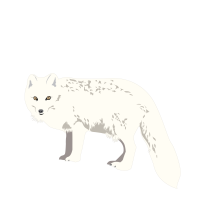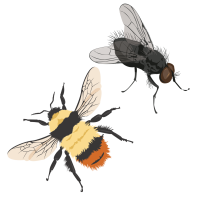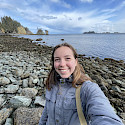
Arctic Biodiversity Monitoring Toolkit
The Arctic Biodiversity Monitoring Toolkit guides monitoring practitioners through stages to implement the Circumpolar Biodiversity Monitoring Program (CBMP).
 The Arctic Biodiversity Monitoring Toolkit helps users access and implement guidance and advice from the CBMP's Arctic Biodiveristy Monitoring Plans and other CBMP products.
The Arctic Biodiversity Monitoring Toolkit helps users access and implement guidance and advice from the CBMP's Arctic Biodiveristy Monitoring Plans and other CBMP products.
The Arctic Biodiversity Monitoring Tookit is comprised of the following elements which can be accessed by the icons below:
- a User Manual: Implementing CBMP Arctic Biodiversity Monitoring Plans in the Field (Step 1-6)
- the Focal Ecosystem Component selection tool
- maps of monitoring locations and data sources
- list of key findings, recommendations and advice from CBMP documents
- data and metadata available on CAFF's Arctic Biodiversity Data Service
- resources including CBMP monitoring plans, templates, guides and more.
User Manual: Implementing CBMP Arctic Biodiversity Monitoring Plans in the field
Experts from the CBMP, the Rif Field Station in Iceland, the Canadian High Arctic Research Station (CHARS), and Zackenberg Research Station in Greenland developed the following steps to implement the CBMP Arctic Biodiveristy Monitoring Plans in the field as part of the International Network for Terrestrial Research and Monitoring in the Arctic (INTERACT).

What questions to ask?
Sample questions critical to the CBMP include:
- What is the current status of [ecosystem] biodiversity in the Arctic?
- Can biodiversity and ecological status in the Arctic be measured with simple variables and indicators, and if so, what suite of variables should be measured?
- How and where are these ecosystems, biodiversity, and processes changing?
- What are the primary environmental and anthropogenic stressors causing changes in biodiversity, and what are the cumulative effects of primary drivers and disturbances?
- Where are the areas of high ecological importance, including, resilient and vulnerable areas, where drivers are having the greatest impact?
- Are biodiversity or Indigenous subsistence food security or food sources being significantly impacted by changes in the Arctic, which species are affected, how are they affected, where are they affected, and what are the expected effects?
- How will in changes in Arctic biodiversity impact the management of biodiversity or other obligations of local, Indigenous, territorial, and federal governments?
What to monitor?
Develop a conceptual ecological model
A conceptual ecological model represents a working hypothesis about key system relationships, functions, and organization. Conceptual ecological models allow for the identification and selection of priority monitoring targets to meaningfully and feasibly describe the status of many parts of the ecosystem and possible causes of change. This is especially critical when monitoring remote and difficult to access Arctic locations, where programs cannot monitor everything, everywhere, all of the time.
Conceptual ecological models for the Arctic, based on science and other expert input, are tools that can provide a common language across diverse experts to identify, elucidate and communicate the critical components, processes, and drivers of ecosystems. Developing a monitoring program based on a structured and well-thought-out ecosystem-based conceptual models generated by diverse expertise can produce a comprehensive, system-based understanding across disciplines that provides the foundation needed to identify a suite of monitoring targets, related attributes, and priority ecosystem structures, functions, and processes, as well as linkages to abiotic and biotic drivers.
Understanding what components of an ecosystem are likely to be affected by driver(s) may prioritize the component or driver(s) for monitoring. Identifying components likely to be influenced first, or most heavily, by any given driver(s), may prioritize the component for sampling design or frequency compared to other components that are likely to change more slowly through time. For these reasons it is important to identify drivers in the development of the conceptual model.
Select monitoring targets, or "Focal Ecosystem Components (FECs)"
The CBMP is based on a three-level hierarchical approach: Focal Ecosystem Components (FECs), attributes, and parameters.
The CBMP Arctic Biodiversity Monitoring Plans identify Focal Ecosystem Components (FECs) in the marine, freshwater, terrestrial and coastal environments. FECs are biological categories of major importance to Arctic residents, considered central to the functioning of an ecosystem, and/or likely to be good proxies of change in the environment. FECs are therefore the targets of monitoring effort in the CBMP and have been selected based on expert opinion.
Attributes describe various aspects or characteristics of each FEC. Lastly, each attribute has a number of potential parameters that are the actual metrics measured in the field. Working in concert, the hierarchical components (FECs, attributes, and parameters) build on one another; individual parameters inform the status of the attributes, and in turn, the attributes collectively inform the status of the FECs.
Example:
| FEC | Attribute | Parameter |
| Caribou/reindeer | Abundance | Number |
| Demographics | Calf percentage | |
| Age composition |
The CBMP has developed an FEC selection tool to assist monitoring professionals to select relevant FECs, attributes, and parameters for their location and contexts while contributing to CBMP implementation. The FEC selection tool contains the most recent information and advice available from the CBMP.
Monitoring in the Arctic is challenging and restricted by access, expense and other factors. The CBMP utilizes existing monitoring capacity to enhance coordination and integration of already established monitoring resources. Through enhanced coordination of existing monitoring resources, there is an improved ability to identify priority gaps in current capacity, and improve comprehensive and cost-effective monitoring.
Co-locating monitoring measurements of FECs at integrated, long-term monitoring sites is highly desirable. To facilitate this approach, the CBMP Arctic Freshwater and Terrestrial Biodiversity Monitoring Plans provide sampling designs for biological components and identify critical abiotic parameters which affect and drive biological change that should be monitored as part of an integrated ecosystem approach.
Implementing CBMP site-based monitoring design is guided by the following questions which would be answered at a site scale:
The CBMP Arctic Freshwater Biodiversity Monitoring Plan identifies a set of criteria for the selection of preferable monitoring sites:
- Sites with high-quality and long-term data sets
- biodiversity hotspots, i.e., areas with high species richness or unique species composition (e.g., rare species) and high conservation value
- medium to small river catchments and lakes to ensure effective sampling effort and representative species collection; and
- sites of high significance to local communities. Additional variables for consideration during the selection of sites may include water source (e.g., glacial vs. non-glacial water bodies), presence or absence of fish, and geomorphic characteristics (e.g., mean stream width, mean lake depth).
Opportunities to integrate CBMP site design with Indigenous Knowledge, community-based programs and citizen science initiatives are highlighted in the CBMP Arctic Biodiversity Monitoring Plans. The CBMP encourages researchers to engage communities in monitoring where possible.
Multi-scale monitoring
Data collection and analytical methods and reporting can be multi-scale and include plot-based ground measures, remotely sensed products, and sampling of species, populations, and communities. Determining the appropriate scale for which to monitor is relative to the monitoring question a program will seek to answer.
At the local (plot or site) scale, data can be collected on individual species, life forms, or functional guilds as appropriate, on ecological interactions and ecosystem functions, and on drivers, to the extent that capacity exists.
At landscape scales, the composition, structure and diversity of populations, communities, or ecosystems will be measured; and finally, at the regional or pan-Arctic scale measures will focus on landscapes and/or regions and relevant features.
Methods that detect change at scales from local to landscape and provide complementary information are essential. Various approaches can be designed as layers and combined during data collection, analysis, and/or reporting. Multi-scale integration between and among monitoring efforts will increase the probability of detecting change, will support up- and down-scaling of identified effects, and will create a more effective monitoring scheme. Monitoring Arctic biodiversity with ground-based sampling and a number of remote sensing platforms in an integrated manner offers an opportunity to complete a pan-Arctic assessment. Ground-based monitoring data can be used to derive local estimates of status, trend, and condition where robust data exist. These ground data can also be used to validate remote sensing products where applicable, which can then be used to extrapolate ground-based resource estimates to broader areas (especially for vegetation characteristics) which are logistically or financially difficult to access or completely inaccessible.
Successful monitoring is built on cooperation between a variety of actors and institutions. In general, it is recommended to link up to national monitoring programs, which can provide guidance and link data generated at a station/site into regional, national, and/or international processes.
It is recommended that each FEC or group of FECs has a scientific lead which is responsible for the monitoring in question and oversight with field scientists.
A field station should ensure a station manager is able to maintain oversight and manage the daily operation of the stations and has access to personnel with data management capacities.
The CBMP suggests that monitoring professionals and field stations develop a monitoring plan to implement CBMP advice.
Monitoring plans can use the structure of CBMP Arctic Biodiversity Monitoring Plans and should:
- Identify monitoring questions, aims and objectives
- Develop conceptual ecosystem model(s)
- Identify a suite of chosen targets for montioring (Focal Ecosystem Components), attributes and parameters, based on the above points
- Describe and map the geographical area
- Decsribe baseline conditions
- Describe monitoring methods and protocols to use
- Identify the frequency of and responsibility for monitoring
- Identify the frequency of and parties responsible for assessments and reporting
- Determine the financial support required
- Identify intended audience(s) for the information generated
- Make clear the links between the monitoring and management decisions
See how the Rif Field Station, in Iceland has developed a monitoring plan including the above components.
Monitoring plan templates and examples
 |
 |
| Template | Example |
As in any monitoring program the data generated is a key program asset. The establishment of an appropriate data management policy is therefore a necessary and important part in the planning process. Such a data management plan should to make sure that data is compatible with other networks and institutions.
Data Management Plans should provide descriptive details of the data collection and processing procedures to be applied the site/field station and should comprise the following components:
- Data management principles: describing the data management principles and guidelines for management of data
- Data collection: describing data collection, storage, and processing
- Data handling: describing how data from will be held and/or delivered
Data management templates and examples
 |
 |
| Template | Example |
CAFF's Arctic Biodiversity Data Service (ABDS) can be used by partners collecting biodiversity data to submit, store and make data available.
Consider the following to ensure that data generated at a site or field station can inform Arctic Council monitoring and assessment activities:
- Submit available data to CAFF's Arctic Biodiversity Data Service (ABDS), an online, interoperable data management system for biodiversity data generated by CAFF activities, including the CBMP; or that the
- Consider interoperability with the ABDS to improve harvesting of the site/station data archive, so that the data can be harvested by ABDS users and the wider Arctic community.
If you have any questions on how to accomplish the above please contact abds@caff.is.
CBMP Arctic Biodiversity Monitoring Plans
The CBMP has developed coordinated Arctic Biodiversity Monitoring Plans for Marine, Coastal, Terrestrial and Freshwater ecosystems to guide and harmonise biodiversity monitoring across the Arctic. The CBMP Arctic Biodiversity Monitoring Plans are consensus expert option about what should be monitored, where, and how, in order to deliver the best possible indications of change in Arctic ecosystems and biodiversity.
The Arctic Biodiversity Monitoring Plans build on existing capacity and encourage the expansion of monitoring initiatives and coverage where opportunities exist. They provide guidelines for priority Focal Ecosystem Components (FECs) that should be monitored to capture the overall status, function, and health of ecosystems and biodiversity. FECs may include ecosystem processes, ecological interactions, and species.
 Arctic Council Working Group
Arctic Council Working Group 



















